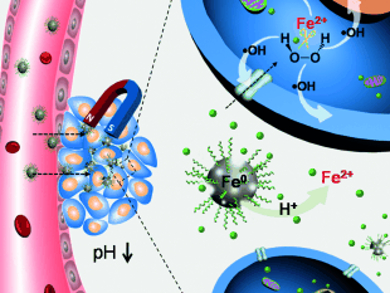Killing Tumor Cells with a Fenton Reaction
Amorphous iron nanoparticles have a specific toxicity in tumor cells. In the journal Angewandte Chemie, Chinese scientists describe their design and synthesis of a special amorphous state of nanoparticulate iron, which can locally release reactive iron species in the acidic and hydrogen peroxide rich environment of cancer cells, providing new possibilities for theranostics and chemodynamic therapies.
Cancer cells are characterized by their relatively acidic cell environment and their production of significant amounts of hydrogen peroxide compared to healthy cells. Some chemodynamic approaches for cancer treatment thus employ the Fenton reaction, that is, iron ions reacting with the hydrogen peroxide to produce reactive oxygen species (ROS), which in turn can damage and destroy the cancer cells. However, the transport of iron ions to the target cells is problematic, and crystalline iron nanoparticles are not as effective.
Amorphous Iron Nanoparticles with Unique Properties
Jianlin Shi and Wenbo Bu and their groups at Shanghai Institute of Ceramics, in collaboration with Fudan University of Shanghai, China, have now prepared iron nanoparticles in an amorphous, glassy state. “Interestingly, the amorphous iron(0) nanoparticles present several unique physicochemical properties,” the scientists write, and: “The results confirm that the amorphous iron nanoparticles, hydrogen peroxide, and acidic conditions act synergistically to kill cells.”
In addition to their potential as drugs, other advantages are a good contrast for magnetic resonance imaging and the possibility of magnetic targeting. “Ideally, a perfect carrier should release its cargo at once when it is transferred from neutral to mildly acidic conditions, such as those in the tumor microenvironment,” the authors write. Using magnetic resonance imaging, they proved by in vitro and in vivo tests that the anticipated mechanism was working.
Magnetic targeting, on the other hand, enables drug delivery to the target tissue through magnetization. The scientists observed that “efficient magnetic targeting and retention had been achieved in vivo, providing a good basis for chemodynamic therapy.” However, they also say that future prospects will include surface modification of the particles to further improve the tumor-targeting performance. In a nutshell, Shi and Bu’s elegant “hubble bubble” approach, as they call it, has produced a tiny, highly effective Trojan horse for chemodynamic cancer therapy, as shown in mice. The preparation method features mild conditions and has prospects for other metals as well.
- Synthesis of Iron Nanometallic Glasses and Their Application in Cancer Therapy by a Localized Fenton Reaction,
Chen Zhang, Wenbo Bu, Dalong Ni, Shenjian Zhang, Qing Li, Zhenwei Yao, Jiawen Zhang, Heliang Yao, Zheng Wang, Jianlin Shi,
Angew. Chem. Int. Ed 2016.
DOI: 10.1002/anie.201510031




